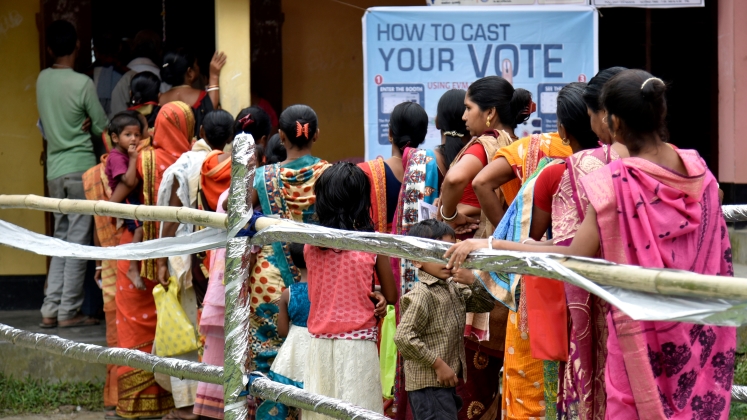Aiming to redefine the core issues at the heart of feminist activism in a development context, Feminist Activism, Women’s Rights, and Legal Reform brings together cases from across the developing world in an effort to analyse the successes, and failures, of the evolution and implementation of new laws designed to protect women and girls. Katherine Williams summarises three fascinating chapters.
 Feminist Activism, Women’s Rights, and Legal Reform. Mulki Al-Sharmani (ed.). Zed Books. 2013.
Feminist Activism, Women’s Rights, and Legal Reform. Mulki Al-Sharmani (ed.). Zed Books. 2013.
The collection, edited by Mulki Al-Sharmani (a Research Fellow at the Academy of Finland and a Theology lecturer at the University of Helsinki) illustrates how feminist engagement with the law can be a complex process, revealing convoluted relationships between state and subject. Gender justice and social change can be achieved, with the law becoming a harmonious catalyst for social transformation. Conversely, the law can also be seen to oppress women; a seemingly insurmountable obstacle to the promulgation and implementation of legal reform that has a positive impact on women’s day-to-day lives.
The volume consists of eight case studies from feminist academics in Palestine, Yemen, Egypt, Bangladesh, Iran, Morocco, Brazil, and Ghana. The case studies focus primarily on the two areas of the law which have been brought to prominence by their respective feminist movements: family and domestic violence laws. The authors examine the various challenges of implementing legal reform after feminist campaigns for social change, and the difficulties of measuring their successes.
In her introductory chapter, ‘Legal Reform and Feminist Activism’, Al-Sharmani discusses how the engagement of Western feminist academic scholarship and the law can be multi-faceted and diverse (p.1). Al-Sharmani unpacks contemporary academic debate regarding the dis/advantages of utilising legal reform as a tool for social transformation. Catharine MacKinnon has argued that the law is the tool by which gender equality and legal reform can be achieved, but others like Carol Smart are sceptical of the transformative nature of legal reform, and are wary of state interference in jurisprudence (p.1). As Al-Sharmani points out, notions of gender can further complicate the question of perceiving and constructing the law as merely a state mechanism. This is especially relevant when discussing Islamic law and the codification of Muslim family laws; such laws are often embedded in tangled webs of power relations between various national actors with vested interests. Consequently, the implications for women are often mixed or marginalising (p.2). Al-Sharmani believes that feminist engagement with the state itself depends on what political cultures are most conducive to the alliances between activists and state actors (p. 10). However, this engagement needs to occur for the issues that affect women to be brought to public attention.
The two additional case studies I found particularly interesting, given the drive in the UK by feminist campaigners to criminalise emotional abuse, were Silvia de Aquino’s analysis of the implementation of the Maria da Penha law in Brazil (Chapter 7), and Takyiwaa Manuh and Angela Dwamena-Aboagye’s analysis of the role of institutions in implementing domestic violence laws in Ghana (Chapter 8).
The Maria da Penha Law was approved in 2006, making it the first Brazilian federal law to address domestic violence (p. 177). Maria da Penha herself is a Brazilian woman who suffered violence at the hands of her husband throughout their marriage. This violence culminated in two attempts on her life, resulting in da Penha being made paraplegic. The approval of the law came as a result of thirty years of organisation by feminist movements. Women had gathered to discuss the issues that affected their lives, and challenged a legal system that allowed men to get away with injuring and even murdering their partners with seeming impunity (p. 180). The political upheaval that followed the years of military dictatorship created conditions for re-democratisation; feminists were able to influence policy, though many women still felt distrustful of the state. However, violence against women was no longer a hidden issue and feminist mobilisation highlighted the intrinsic link between the private and political realm, lending credence to the old feminist adage that the personal is indeed political.
De Aquino is part of the Maria da Penha Observatory (est. 2007), which aims to monitor how the law is implemented and enhance policy measures regarding violence against women. Comprising twelve research and NGO organisations, the Observatory focuses primarily on the implementation of the Maria da Penha Law (p. 188). Their fieldwork so far has involved distributing questionnaires to women’s police stations across the five regions of Brazil. De Aquino advocates for a better understanding of the Maria da Penha Law across all public services in order for implementation to be a success (p. 194). There also exists a need to extend networks of care for women, and more information is needed on the impact of specialised services for women (p. 196-7). Perhaps the biggest challenge is changing public perceptions regarding gender-based violence; despite being sentenced to fifteen years in prison for the attacks on his wife, the ex-husband of Maria da Penha had his conviction overturned and eventually only served two years for his crimes.
Similarly, a domestic violence act was passed in Ghana in 2007 after years of campaigning by feminist activists. A national study by the Accra-based Gender Centre revealed that one in three Ghanaian women had experienced gender-based violence, 20% of the respondents had been raped, and 8% had their economic freedoms curtailed (p. 203). Most sobering of all, 95% of respondents had not reported these crimes to the police (p. 203-4). Manuh and Dwamena-Aboagye note that the analysis of such data has revealed that violence against women can be traced to dominant social discourses regarding the perception of men and women in Ghanaian society. Gender-based violence is not considered unusual in Ghana, the authors believe, and despite Ghana being a signatory of the African Charter on Human and Peoples’ Rights and CEDAW, the state was not fulfilling its obligation to women (p. 203-4). The domestic violence act aims then to provide an effective legal framework by which domestic violence can be addressed. The challenges facing feminist and women’s organisations working alongside the state are vast: lack of funding for service provision and training, geographical limitations, and inadequately trained personnel all present obstacles to successful implementation (p. 205). However, the authors find that the biggest implementation challenges of all are the political will to change and the institutional opposition to ‘foreign’ beliefs and practices which detractors of the act believe are infiltrating Ghanaian culture (p. 208).
The diverse case studies presented in Feminist Activism, Women’s Rights, and Legal Reform allow their respective authors to analyse elements that can either help or hinder legal reform. The collection gives the reader an in-depth understanding of the frameworks under which feminist activism takes place. Despite the unprecedented successes of feminist and women’s movements across the globe, the implementation of new laws designed to protect women requires not only passion and campaigning from women themselves, but the political will of a state truly committed to social change, as the case studies analysed have shown only too well.
Katherine Williams graduated from Swansea University in 2011 with a BA in German and Politics, and is currently studying for a MA in International Security and Development. Her academic interests include the de/construction of gender in IR, conflict-driven sexual violence, and memory and reconciliation politics. You can follow her on Twitter @polygluttony.








2 Comments